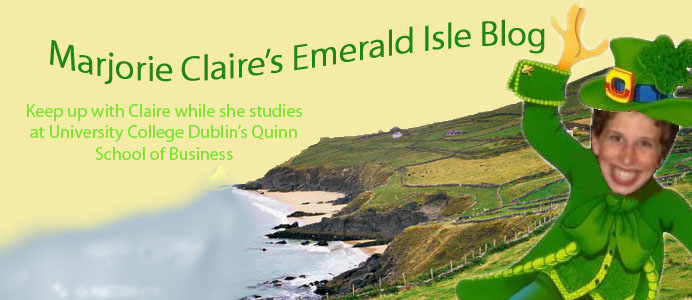Entrance to Kilmainham Goal in Dublin. This entrance was also the sight of public hangings.
The Kilmainham Gaol had been on my must-see list since I read about Dublin and after getting a good foundation on Irish revolutionaries in Irish History class I decided to check it out. Rick Steves gave it three triangles and it did not disappoint.
The first challenge was getting to Kilmainham, which was over 30 minutes walking time from the city centre. But I could use the exercise and I didn’t want to pay for the bus so I made the trek. I showed up just in time for the guided tour at 2:30 with Anthony, who was great. I bought the Heritage Pass while I was there that gets one into many historical sights for free for one year. I also got a booklet about all the historical sights but it is in Irish. I don't know why you would put a tourist pamphlet in Irish but they did and I can't read it.
Chapel in the jail. The marriage between Joseph Plunkett and Gail Gifford (who later returned as a prisoner) took place here the night before his execution. He was involved in the Easter Uprising. The alter was carved by a prisoner.
During the guided tour you walked around the jail itself. Anthony talked about various prisoners, including Robert Emmet (subject of the history presentation I gave on Wednesday), Charles Parnell, and Padraig Pearse. He also talked about the conditions of the jail because it was considered a model for Victorian jails where the inmates were put in separate cells. It was an extremely interesting tour and anyone with an interest for Irish revolutionaries should be sure to see it.
Door to Robert Emmet's cell
At the end of the tour there was also a museum which had various facts about the jail, including a list of people who got put in during the Great Famine and their crimes, which often included stealing food. Getting put in Kilmainham was sometimes life saving during the Great Famine because the prisoners were at least fed, but there was also a lot of disease that a weak person could succumb to. They also had a separate room with famous inmates’ objects, including diaries, letters, and personal belongings. They even had Wolf Tone’s and Robert Emmet’s death masks, which were somewhat creepy but also reminded me that they were real people, not just words on a page in my history book. One of the patriots of the Easter Uprising, Mallin, who was executed here wrote a letter to his family saying goodbye and encouraging his youngest son to become a priest. The son did become a priest and still visits the prison every couple of years, the last living child of anyone executed there.
Cell
Exercise yard. All inmates were subject to hard labour which may include breaking rocks or simply unwinding rope. This is also used in the TV series The Tudors for all the execution scenes.
Sight of the execution of most of the Easter Uprising conspirators. James Connolly was executed on the other side of the yard.
I love the atmosphere of the city, especially walking down Grafton Street with all the street performers. Yesterday I was walking home after church and a man with a guitar and harmonica was playing “Take Me Home Country Roads,” one of my absolute favorites. Today as I was walking down Grafton and “Forever Young” was playing, another great song, as I walked down the street independently and it was one of those “Who Will Buy?” moments (what is a blog entry if you don’t make a musical theatre reference?) But I have those moments that I wish I could put in a box and keep forever all the time while I’m here. Hopefully this blog will function as a memory box for some of the perfect moments I’ve experienced.














No comments:
Post a Comment